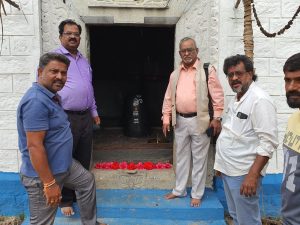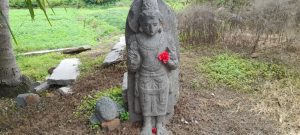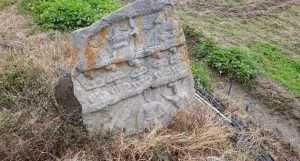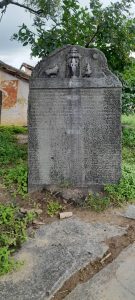
Abandoned Shivalinga in Karnataka may hold key to 'missing' Chola temple
The supposed 'disappearance' of a 1,000-year-old temple, built by the Chola or the Ganga dynasty in Tumkuru, has evoked interest; what remains now are a few ancient-looking idols in a make-shift shelter. A ground report by The Federal

The recent conjecture that a nearly 1,000-year-old Chola temple in present-day Tumkuru has probably gone missing has had some surprising ramifications. It has turned the spotlight on an abandoned Shiva temple with a grand Shivalinga in a nondescript village located 120 km from Bengaluru.

It is suspected that the structure sits on the ruins of a 949-year-old temple built by a descendant of Rajaraja Chola I, and that the Shivalinga it houses belongs to that ancient temple. While there are some experts who insist this must be the case, there are others who argue that it can’t be. There is historical and archaeological evidence that both camps cite.
How the debate began
AG Ponn Manickavel, former Inspector General of Police in charge of the Idol Wing in Tamil Nadu, recently wrote a letter to the Archaeology and Endowment Department of the state, bringing to its notice the supposed existence of a ‘missing’ temple built 949 years ago by a Chola king in Tumkuru district of Karnataka.
According to Manickavel, an old Tamil stone inscription was engraved on the order of the king, Swasthi Shri Udayar Rajadhiraja Thevar. “Five years after the death of emperor Swasthi Shri Udayar Rajendra Chola Thevar, his son Rajadhiraja Thevar, in honour of his deceased father, constructed a Sivan temple called Rajendra Choleeswaram,” said the inscription. The inscription refers to Kunigal as a flourishing and famous commercial capital.

There is also a stone inscription in Old Kannada found in the same area, which belonged to the Hoysala dynasty, around the time of the Hoysala King Vishnuvardhana.
Subsequently, Karnataka Archaeological Department officials visited the Gottigere area, where this ancient Chola temple is supposed to have existed, for a survey, which is yet to be concluded.
What’s visible now
The Federal visited this serene village in Gottigere, which has now come under the radar of archaeologists. Located just 5 km away from Kunigal town in Tumkuru district, it is also close to the famous Kunigal lake built by Ganga dynasty king Sripurusha. Friendly locals offer you a two-wheeler ride to reach the now-famous spot.

If you expect to see grand remnants of a Chola temple, akin to the Big Temple in Tanjore, you will be disappointed. Instead, amid green paddy fields and areca trees sit two small blue-and-white painted brick structures housing a Shivalingam and a Nandi. Also, in the 100×100 sq ft area, there’s a Surya idol, a shakti kallu (a stone with a few symbols engraved on it), and a Jain Tirthankara-like idol.
This neglected temple with a sizable Shivalinga is the responsibility of the Muzrai department of Karnataka, but it is the humble locals who have put together a small, protective shed-like structure over it. There are many historical temples in different corners of the country in a similar dismal condition but this temple is now the cynosure of all eyes because it is ostensibly connected to the Cholas.

Also read: Muzrai & Mandir: Money and power play in Karnataka temples
The door to the temple structure that houses the Shivalinga has no locks. At the entrance, a lotus has been carved on a horizontal stone slab and a number of hibiscus flowers are placed on it. Inside sits a beautiful, roughly 4-foot-high Shivalingam. There’s just a pooja bell, a brass pooja plate and an empty oil bottle on the floor.

The locals said that they have asked a priest to perform daily poojas at this temple, but it hardly ever takes place. A few bilva patra leaves from the nearby bilva tree have been placed on top of the Shivalinga.
Though the presence of this Shivalinga tells the story of the probable existence of an ancient temple in the area, the current edifice sports an abandoned look. It is interesting that the Shivalinga faces the west, while the norm is the east. Locals say the only other temple which has the Shivalinga facing the west is the Gavi Gangadhareshwara temple in Bengaluru.
In front of the Shivalinga, there is another brick-walled shelter, in which a 3-foot-high feet Nandi sits in lone splendour. The villagers have placed some pooja materials near the Nandi.
There is much local folklore about the idol. Shankarappa, a farmer, told The Federal his forefathers used to talk about how the sun’s rays touched the Shivalinga on Makar Sankranti day, considered a sacred day.

Villagers claim that the Shivalinga has a bow and arrow mark which they believe is Lord Rama’s arrow and known as Ramalingeshwar by their forefathers. None of this is confirmed by experts.
According to farmer Shankarappa, this place was known as Ganganalli and the Shivalinga was buried under the bushes. Only 20 years ago, the villagers built a temporary structure to keep it safe. His ancestors also told him about a big temple, with a pushkarani (a small pond for the temple) and a kallu mantap.
Another villager, Ramesh, said the vestiges of an ancient temple are strewn all over the area in the form of stone statues, pieces of idols, traces of pots, and the head of a Jain tirthankara-like idol. The villagers also found a foot of a statue and a shakti kallu (a stone with a few symbols and an image of a king probably who ruled the area) behind the Nandi.
The villagers want a government agency to look after the temple but there seems to be no move in that direction. “A priest who performs the pooja at a nearby temple comes here now and then,” said Nagaraj.
Also read: ASI revives underwater archaeology wing, TN can now unearth Poompuhar
TN cop’s Rajendra Chozhiswaram theory
In a letter to PK Sekar Babu, Tamil Nadu Minister for Hindu Religious and Charitable Endowment, Ponn Manickavel said Sri Udayar Rajadhi Raja Devar I, the grandson of Rajaraja Chola I and son of Rajendra Chola I, had established a town named Rajendra Cholapuram at Kunigal in Tumkur district.
The Federal tried to contact Pon Manickavel but he was not available for comment.

He had built a temple named ‘Rajendra Chozhiswaram’ 949 years ago, in memory of his father, at Kothagere, and the king donated a rare bronze Nataraja idol called ‘Rajadhiraja Vindhagar’ to the temple, besides valuables and stone idols. Manickavel also claimed that the temple is no longer found in the village. Stone inscriptions about the temple are lying near a recently built temple in the village, he wrote.
Archeologist Amarnath Ramakrishnan of the Archaeological Survey of India’s (ASI) Chennai Circle, pointed out that King Raja Raja Chola had conquered the regions of Gangavadi and Nolambavadi, and he had built many temples. There are stone inscriptions proving this even today.
“Over a period of time, however, those temples become dilapidated due to poor maintenance. When people take up renovations of these ancient temples they bring down the existing structure and build a modern one. That doesn’t mean the temple has disappeared. In this case, it needs more study by the ASI officials,” he told The Federal.
What Karnataka experts say
However, historian and editor of Karnataka Gazetteers, Dr S Revanna, who did his research work on Kunigal-Nadu, does not subscribe to the theory that the temple was built by the Cholas. He told The Federal: “This temple, where the Sivalinga is situated, was referred to as Ganganalli (Gangana halli) and the name may be derived from the Ganga kings, not the Cholas.”
Further, he said, the Kunigal lake was built by king Sripurusha of the Ganga dynasty, as described in the inscriptions. Later, the Rastrakuta kings ruled the area and it was mentioned in the inscriptions. It was later ruled by the Hoysalas, who were defeated by the Cholas. Tumkuru, Kolar and other areas were ruled by the Cholas. At that time, the Chola king might have donated a few items to the particular temple and named the area as Rajendra Cholapuram,” he added.
An ancient temple for sure
Kunigal Manju, a research assistant, said this temple is definitely an ancient one. “It can’t be called a Chola temple, but it is ancient,” he added.
According to him, three small rivers, namely Kamala, Nalini and Nagini, originate from Shivaganga Betta (hill) and they converge at Simcha to join the Cauvery. The Kunigal lake is filled with the water of these three rivers and this Shiva temple may be built at the bund of the Nagini. (Currently, these rivers do not exist).
He explained that the Ganga dynasty built such temples as they ruled Kolar, Talakadu, Channapatna areas and the surrounding areas. Later, they were defeated by the Chola kings. But, the temples near the Kunigal lake were mostly built by Gangas. Sripurusha’s son, the Ganga king, later converted to Jainism and this may be the reason there are traces of Jain worship as well in the area.
Kannada and Tamil inscriptions
Stone inscriptions in old Kannada and Tamil have been found in various spots in the area, according to experts. There may be other proofs which may be lying underneath the stone and can be studied only after proper excavation. Gopal Rao, a historian who visited the place along with archaeological departmental officials, however, declined to comment for this article.
Meanwhile, R Gopal, director of the Karnataka Archaeology Department, summarised the entire situation as: “A Shivalinga belonging to the 10th or 11th century, a Nandi idol in front of the Shiva idol built during the Vijayanagara period, and a Sun God idol belonging to the 9 or 10th century were found in and around the premises of the Shiva temple.”
(With inputs from N Vinoth Kumar)

